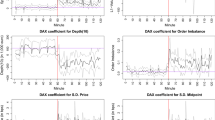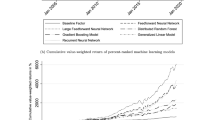Abstract
This study presents an analysis of the impact of the introduction of quotes in sixteenths of a dollar on the AMEX, Nasdaq, and NYSE in mid-1997 on select market characteristics such as spreads, effective spreads, quoted depth, and volume. The findings of the study document reductions in the bid-ask spread, effective spread, and a statistically significant increase in the number of quotes. Interestingly, we find that liquidity, as measured by the total depth at the bid and ask, declines significantly on the AMEX and NYSE, but increases on the Nasdaq. Trading volume increases on the NYSE, but remains unchanged for the AMEX and Nasdaq. We also find that the proportion of even-increment quotes is a relevant factor affecting percentage spreads for Nasdaq both before and after and for the NYSE only after the change in quoting increments.
Similar content being viewed by others
References
Ahn, H., C. Cao, and H. Choe, “Tick Size, Spread, and Volume.” Journal of Financial Intermediation 5, 2–22, (1996).
Bacidore, J., “The Impact of Decimalization on Market Quality: an Empirical Investigation of The Toronto Stock Exchange.” Journal of Financial Intermediation 6, 92–120, (1997).
Barcley, M., “Bid-ask Spreads and The Avoidance of Odd-eight Quotes on Nasdaq: An Examination of Exchange Listings.” Journal of Financial Economics 45, 35–60, (1997).
Bessembinder, H., “The Degree of Price Resolution and Equity Trading Costs.” Journal of Financial Economics 45, 9–34, (1997).
Bessembinder, H., “Trade Execution Costs on Nasdaq and the NYSE: A Post-Reform Comparison.” Forthcoming. Journal of Financial and Quantitative Analysis (1999).
Christie, W. and P. Schultz, “Why Do NASDAQ Market Makers Avoid Odd-eight Quotes.” Journal of Finance 49, 1813–1840, (1994).
Crack, T., Tinkering with ticks: choosing minimum price variation for the US equity markets. Working paper, Indiana University (November 1995).
Godek, P., “Why Nasdaq Market Makers Avoid Odd-eight Quotes.” Journal of Financial Economics 41, 465–474, (1996).
Goldstein, M. and K. Kavajecz, “Eights, Sixteenth, and Market Depth.” Forthcoming. Journal of Financial Economics (1998).
Griffiths, M., B. Smith, D. Turnbull, and R. White, “The Role Of Tick Size In Upstairs Trading And Downstairs Trading.” Forthcoming. Journal of Financial Intermediation (1998).
Harris, L., “Minimum Price Variations, Discrete Bid-Ask Spreads, and Quotation Sizes.” Review of Financial Studies 7, 149–178, (1994).
Harris, L., Decimalization: a review of the arguments and evidence. Working paper, The University of Southern California (April 1997).
Huang, R. and H. Stoll, Tick size, bid-ask spreads, and market structure. Working paper, Vanderbilt University, (1999).
Ip, G., “Stock Volatility Blamed On Move To Sixteenths.” The Wall Street Journal, July 2, C1. (1997).
Ip, G. and P. Mcgeehan, “Big Board Votes Trades In Decimals.” The Wall Street Journal, June 6, C2. (1997).
Jones, C. and M. Lipson, Sixteenths: direct evidence on institutional trading costs. Working paper, Columbia University, (1998).
Lau, T. and T. Mcinish, “Reducing Tick Size on the Stock Exchange of Singapore.” Pacific-Basin Finance Journal 3, 485–596, (1995).
Lohse, D., “Quoting Stocks in Smaller Ticks Has Advantages.” The Wall Street Journal, March 17, C1, (1997).
McInish, T. and M. McCorry, Reducing tick size on the Australian Stock Exchange. Working paper, The University of Memphis, (1997).
Porter, D. and D. Weaver, “Tick Size And Market Quality.” Financial Management 26, 5–26, (1997).
Ricker, J., Breaking the eight. Working paper, Sixteenths on the New York Stock Exchange, (1998).
Ronen, T. and D. Weaver, Teenies anyone? The case of the American Stock Exchange. Working paper, Baruch College, City University of New York, (1998).
Schroeder, M., “Proposal To Trade Stocks In Decimals Gets Sec Boost.” The Wall Street Journal, May 21, 1997, C2, (1997).
Simaan, Y., D. Weaver, and D. Whitcomb, The quotation behavior of ECNs and Nasdaq market makers. Working paper, Baruch College, City University of New York, (1998).
Author information
Authors and Affiliations
Rights and permissions
About this article
Cite this article
Van Ness, B.F., Van Ness, R.A. & Pruitt, S.W. The Impact of the Reduction in Tick Increments in Major U.S. Markets on Spreads, Depth, and Volatility. Review of Quantitative Finance and Accounting 15, 153–167 (2000). https://doi.org/10.1023/A:1008369114062
Issue Date:
DOI: https://doi.org/10.1023/A:1008369114062




